#der blaue reiter
Photo

Wassily Kandinsky (Russia 1866–1944 )
"Several Circles", 1926
3K notes
·
View notes
Text

Franz Marc
Cats
1910
#franz marc#cats#cat art#cats of tumblr#animals#animals in art#german artist#german painter#german expressionist#expressionism#expressionist#expressionist painting#expressionist art#der blaue reiter#modern art#art history#aesthetictumblr#tumblraesthetic#tumblrpic#tumblrpictures#tumblr art#aesthetic#beauty
699 notes
·
View notes
Text

Franz Marc (German, 1880–1916) and Wassily Kandinsky (Russian, 1866–1944) with a woodcut print of the cover of Der Blaue Reiter almanac (1912), on the porch of Ainmillerstr. 36, Munich
Photograph by Gabriele Münter
49 notes
·
View notes
Text

Franz Marc (German, 1880-1916) • Dreaming Horse • 1913 • Solomon R. Guggenheim Museum, New York
#art#painting#fine art#art history#franz marc#german expressionism#german artist#early 20th century european art#expressionism#modern art#animals in paintings#degenerate art#artwork#der blaue reiter#pagan sphinx art blog#art blog#art appreciation#museum aesthetic#paintings i've seen
36 notes
·
View notes
Text

Wassily Kandinsky, The Waterfall, 1909, oil on pasteboard (Yale University Art Gallery, New Haven)
32 notes
·
View notes
Text

Gabriele Munter, Beach at Bornholm, 1919.
Private Collection.
#1919#painting#gabriel munter#art#Beach at Bornholm#beach#bornholm#summer#summer painting#Gabriele Münter#expressionist painter#avant-garde#Der Blaue Reiter#bornholm denmark#denmark#summer in denmark#summer holiday#summer day#summer time#summer vibes#fine art
46 notes
·
View notes
Text
#ThreeForThursday:
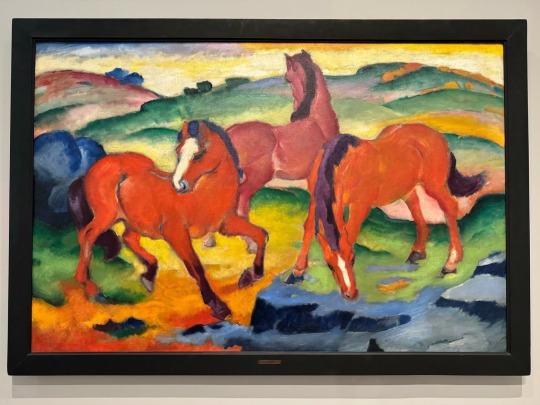
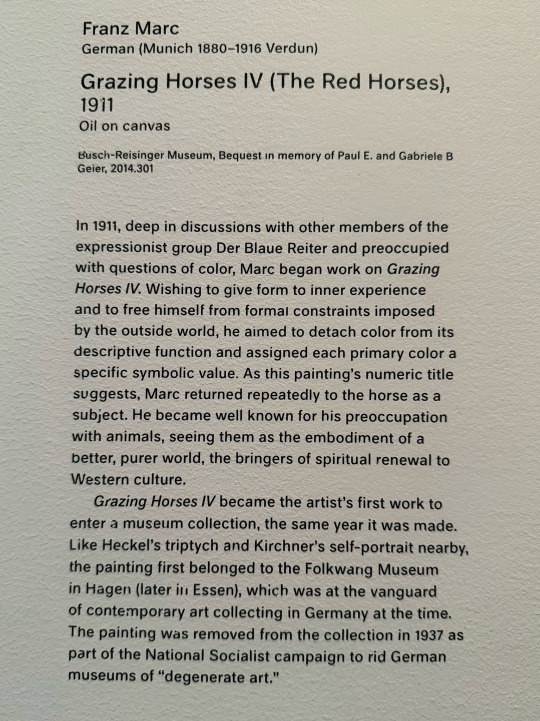
Franz Marc (German, 1880-1916)
Grazing Horses IV (The Red Horses), 1911
Oil on canvas, 121 x 183 cm (47 5/8 x 72 1/16 in.)
On display at Harvard Art Museums
“In 1911, deep in discussions with other members of the expressionist group Der Blaue Reiter and preoccupied with questions of color, Marc began work on Grazing Horses IV. Wishing to give form to inner experience and to free himself from formal constraints imposed by the outside world, he aimed to detach color from its descriptive function and assigned each primary color a specific symbolic value. As this painting's numeric title suggests, Marc returned repeatedly to the horse as a subject. He became well known for his preoccupation with animals, seeing them as the embodiment of a better, purer world, the bringers of spiritual renewal to Western culture.
Grazing Horses IV became the artist's first work to enter a museum collection, the same year it was made. Like Heckel's triptych and Kirchner's self-portrait nearby, the painting first belonged to the Folkwang Museum in Hagen (later in Essen), which was at the vanguard of contemporary art collecting in Germany at the time.
The painting was removed from the collection in 1937 as part of the National Socialist campaign to rid German museums of ‘degenerate art.’”
Bonus #BookRecommendation:
Franz Marc: Horses (2000)
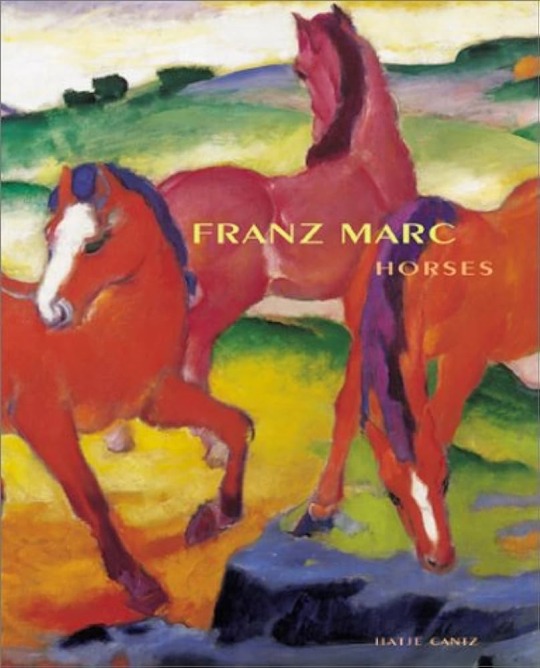
#animals in art#european art#20th century art#museum visit#German art#german expressionism#der blaue reiter#Franz Marc#Harvard Art Museums#1910s#trio#Three for Thursday#painting#oil painting#horse#horses#book recommendation#Amazon Associates
11 notes
·
View notes
Text
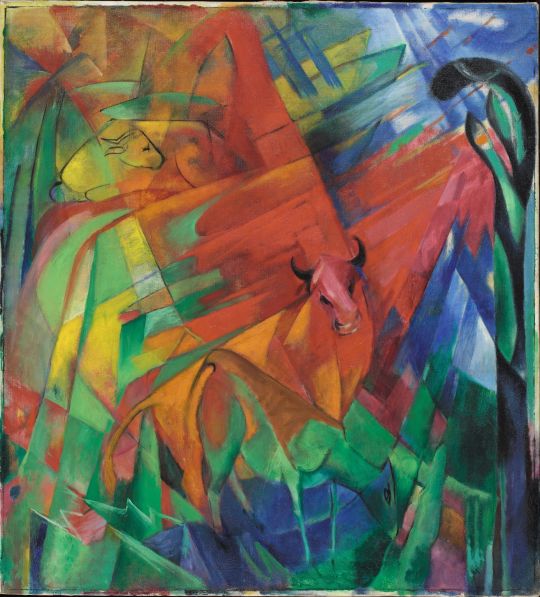
Franz Marc, Animals in a Landscape, 1914, oil on canvas. Detroit Institute of Arts
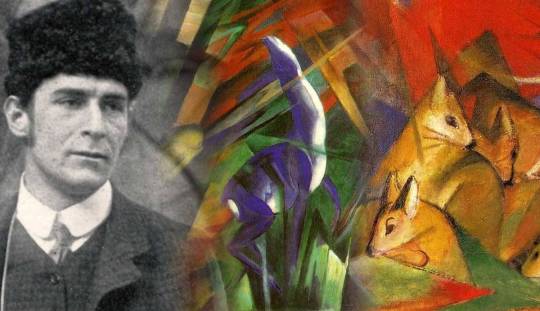
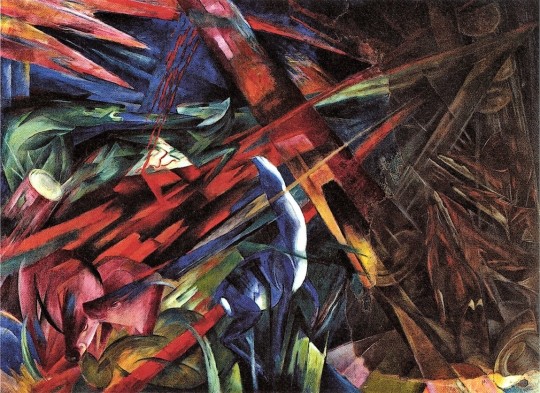
"Fate of the Animals" by Franz Marc, 1913. Oil on canvas.
Why Did Franz Marc Paint Animals?
The great early 20th century German Symbolist and Expressionist painter Franz Marc is now world-renowned for making paintings featuring a huge variety of animals, from cows and horses to deer and foxes. A member of Der Blaue Reiter (The Blue Rider) group, a group of international artists based in Munich who experimented with Abstraction and Expressionism. Initially founded by Wassily Kandinsky and Franz Marc, other members included Paul Klee, August Macke, Marianne von Werefkin and Alexej von Jawlensky.
He was expressing a personal mythology - In many of his paintings, Franz Marc explored how animals could become potent symbols for human experiences and emotions. When painting animals in unusual or unexpected colors, he translated animal forms into otherworldly, abstract metaphors, with bright colors signifying different states of mind.
He used animals to symbolize an age of innocence - For Marc, animals symbolized a pre-industrial age of innocence, when people lived in close harmony with the land.
Animals signified freedom and the spiritual world - The color blue was particularly significant signifying a passageway into the spiritual world. Marc brought these theories into play most eloquently in his ‘Blue Horses’ series, where iridescent blue horses twist this way and that like symbols from a dream. Marc also considered horses to be a metaphor for travelling and journeys, further emphasizing his desire to express states of transition in his art.

"Blue Horse 1" by Franz Marc, 1911
He expresses a pantheistic vision of life - Believing strongly in the importance of unity between people, animals and nature, his art expressed his desire to hold on to this status within the world, rather than giving in to the destructive potential of the modern machine age. He wrote, “I seek pantheist empathy with the vibration and flow of the blood of nature – in the trees, in the animals, in the air… I see no happier medium for the ‘Animalization’ of art, as I would like to call it, than the animal picture.”
He highlighted the anxieties of the modern age - In his apocalyptic scene The Fate of the Animals, 1913, Marc paints a shattered vision of the world, broken into kaleidoscopic shards as desperate animals twist this way and that in a bid for survival. By contrast, in the center of the image Marc places a blue deer, a symbol of hope amidst the chaos that swirls all around it.
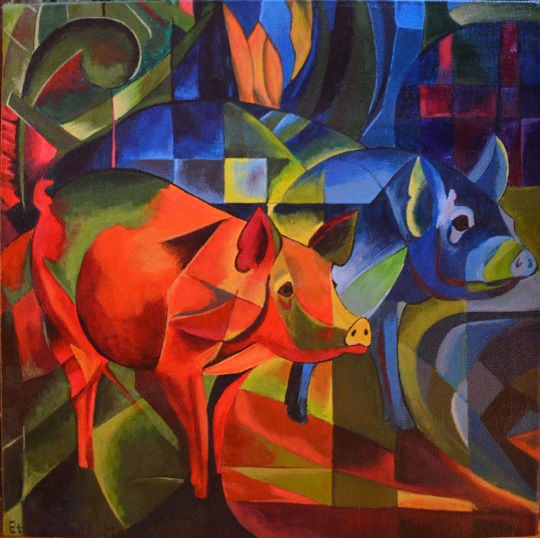
"Piggies" by Franz Marc (1913)
#franz marc#animals in a landscape#art#paintings#animals#landscape#dia#symbolism#abstract#expressionism#blue horse#piggies#der blaue reiter#the blue rider
28 notes
·
View notes
Photo

Franz MARC (1880-1916)
“Tiger” (1912)
Holzschnitt - Woodcut
Sammlung / Collection ALBERTINA Wien / Vienna
Ausstellung / Exhibition
Dürer, Munch, Miró.
The Great Masters of Printmaking
ALBERTINA Wien / Vienna - 2023
#franz marc#tiger#Albertina Vienna#the masters of printmaking#marc#german expressionism#Der Blaue Reiter#vassily kandinsky#munich#august macke#bernhard koehler#neue künstlervereinigung#münchen
38 notes
·
View notes
Photo

The tiger by Franz Marc
#Tiger#Franz Marc#famous#famous artist#artist#artwork#der blaue reiter#germany#expressionism#animals#animal painting#animal art#art#kunst#künstler#kunstwerk#malerei#malen#kunstdruck#art print#colorful#color theory#bunt
3 notes
·
View notes
Photo

August Macke (Germany 1887=1914)
Frau im Garten (Woman in garden) 1911
205 notes
·
View notes
Text
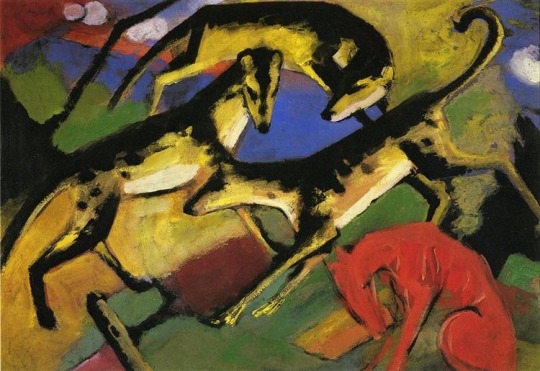
Franz Marc
Playing Dogs
1912
#franz marc#der blaue reiter#dogs#dog art#dogs in art#animals in art#german artist#german painter#german painting#german art#beautiful dogs#beautiful animals#modern art#art history#aesthetictumblr#tumblraesthetic#tumblrpic#tumblrpictures#tumblr art#aesthetic#beauty
974 notes
·
View notes
Photo

Franz Marc
Liegender Stier (1913)
54 notes
·
View notes
Text

Franz Marc (German, 1880–1916) • Das Äffchen (The Little Monkey) • 1912 • Lenbachhaus, Munich, Germany
#art#painting#fine art#art history#franz marc#german artist#german expressionism#early 20th century european art#der blaue reiter#the blue rider#german art movement#colorful art#animals in art#oil painting#pagan sphinx art blog#art blogs on tumblr
10 notes
·
View notes
Text
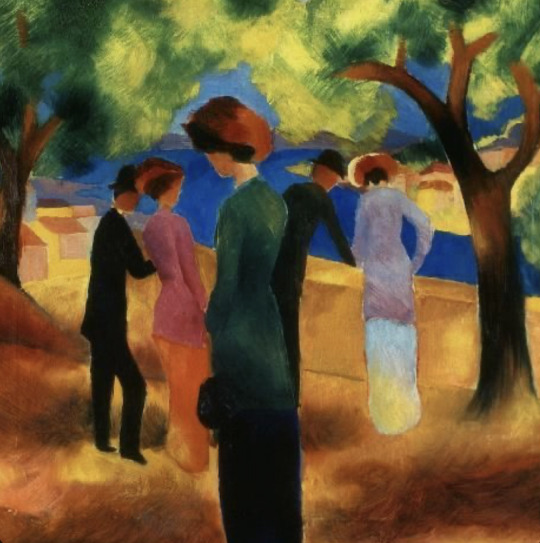
August Macke (German, 1887-1914)
Green jacket, 1913
11 notes
·
View notes
Text
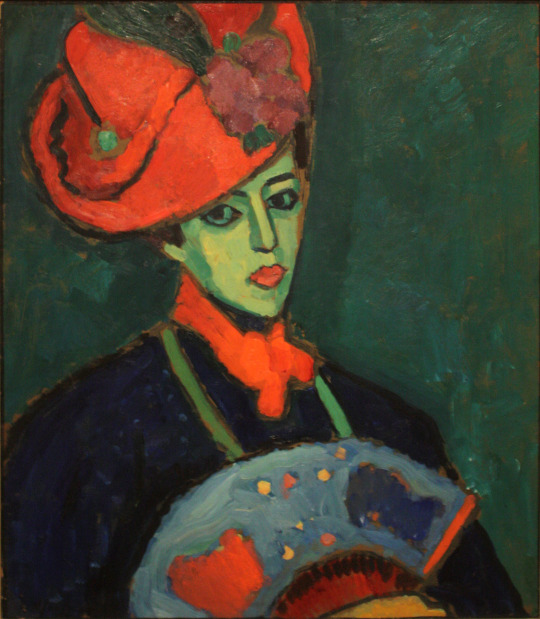
Alexei von Jawlensky, Schokko with Red Hat, 1909, oil/board (Museum of Art, Columbus [Ohio])
10 notes
·
View notes